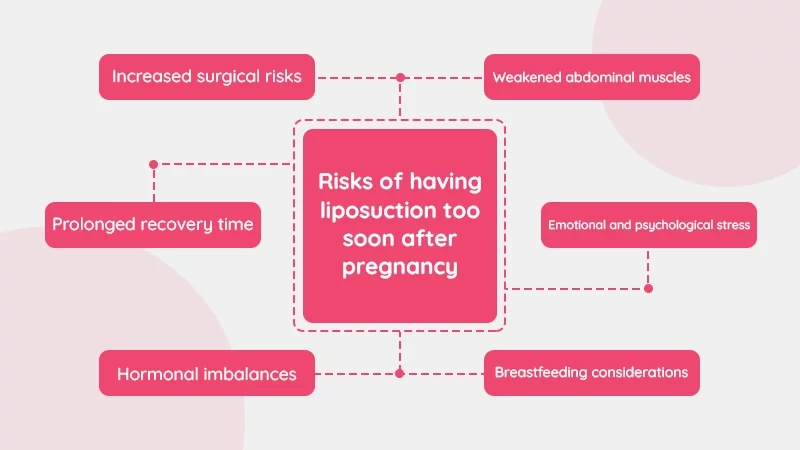Published on 20 Oct 2024
How Soon After Giving Birth Can I Have Liposuction?
- ByMedical Content Team
- Medically Reviewed byDr. Sabine Kulhanek
Fact checked

- Post-pregnancy body changes
- The healing process after childbirth
- Is liposuction after pregnancy safe?
- How soon is it safe to have liposuction after pregnancy?
- Risks of having liposuction too soon after pregnancy
- Benefits of liposuction after pregnancy
- Should I have a tummy tuck or liposuction after pregnancy?
Bringing a new life into the world is an incredible journey that brings immense joy and fulfillment. However, pregnancy and childbirth also bring significant changes to a woman's body. For many new mothers, regaining their pre-pregnancy shape can be a challenging and often frustrating process. While diet and exercise play crucial roles in postpartum recovery, some areas of stubborn fat may remain resistant to these efforts.
Liposuction, a popular cosmetic procedure, offers a solution for those looking to enhance their body contour and restore their confidence after pregnancy. But how soon after giving birth is it safe to consider liposuction? Keep reading this article for comprehensive information on the appropriate timing for liposuction after childbirth. We'll explore the healing process, key factors to consider, and expert recommendations to help you plan your postpartum journey effectively.
Post-pregnancy body changes
Pregnancy and childbirth bring about profound changes to a woman's body, many of which can be surprising and sometimes challenging to manage. Understanding these changes is the first step in determining the right time for any cosmetic procedure, including liposuction.
Weight gain
During pregnancy, it is normal and healthy to gain weight to support the growing baby. This weight gain includes the baby’s weight, placenta, amniotic fluid, increased blood volume, and additional fat stores. After delivery, while some weight is lost immediately, a portion often remains.
Skin elasticity
The skin stretches significantly during pregnancy to accommodate the growing belly and breasts. Postpartum, the skin may not immediately bounce back to its pre-pregnancy state. Factors like age, genetics, and the amount of weight gained can influence skin elasticity.
Hormonal changes
Hormones like estrogen and progesterone fluctuate significantly during and after pregnancy. These hormonal shifts can affect fat distribution and retention, influencing how the body looks and feels postpartum.
The healing process after childbirth

A key milestone in postpartum recovery is the six-week check-up with a healthcare provider, where overall health, healing progress, and emotional well-being are assessed. This check-up is an opportunity to discuss any concerns and receive guidance on resuming normal activities.
Gradual physical activity, starting with gentle exercises, helps rebuild strength and stamina, with more strenuous activities added as the body heals. Understanding these changes and the importance of the healing process is crucial before considering cosmetic procedures like liposuction. Allowing sufficient time for natural recovery and following professional medical advice ensures a safe and healthy approach to postpartum body contouring.
Recovery times can vary significantly from one person to another. Factors such as overall health, the amount of weight gained during pregnancy, and whether the delivery was vaginal or via cesarean section can influence the optimal timing for liposuction.
Is liposuction after pregnancy safe?
Liposuction after pregnancy can be safe, but it is essential to consider several factors and take necessary precautions. There are inherent risks associated with any surgical procedure, including infection, bleeding, and adverse reactions to anesthesia. Postpartum, the body may still be in a state of recovery, and undergoing surgery too soon can increase these risks. Therefore, while liposuction after pregnancy can be safe, it requires careful consideration of timing, health status, and professional medical advice to ensure the best possible outcome. Prioritizing natural recovery and thorough consultation with healthcare providers will help mitigate risks and enhance the safety of the procedure.
How soon is it safe to have liposuction after pregnancy?
Determining the right time to have liposuction after pregnancy involves understanding both the body's healing process and individual circumstances. General guidelines suggest waiting at least six to twelve months after childbirth before considering liposuction. This waiting period allows the body to naturally recover from the physical and hormonal changes of pregnancy and childbirth. This period also allows the uterus to return to its normal size, hormones to stabilize, and breastfeeding (if applicable) to establish or conclude.
Waiting up to twelve months can provide additional benefits, as the body continues to adjust and lose pregnancy weight naturally. This is especially recommended for mothers who have had a Cesarean section. Recovery from a C-section is more extensive because of major abdominal surgery, and the body needs more time to heal from the surgical incision and internal healing. Most healthcare providers recommend waiting at least eight months to a year after a C-section before considering liposuction. This allows sufficient time for the body to heal, reducing the risk of complications and ensuring better results.
If you’re going to be breastfeeding, it is generally recommended to wait until after you have finished breastfeeding before having liposuction. This is because hormonal changes during breastfeeding can affect fat distribution and skin elasticity, and medications used during the surgery can pass into breast milk. Waiting ensures the best results and minimizes risks for both you and your baby. Always consult with your healthcare provider to make the best decision for your specific situation.
Also Read: 11 Common Liposuction Myths Debunked
Risks of having liposuction too soon after pregnancy

Undergoing liposuction too soon after giving birth can increase several risks and complications. The postpartum period involves significant physical and hormonal changes, and the body needs adequate time to heal. Here are some of the risks associated with having liposuction too soon after childbirth:
- Increased surgical risks: The body is still recovering from childbirth, which can increase the risk of surgical complications such as infection, excessive bleeding, and poor wound healing. The immune system and physical resilience may not be fully restored, making it harder to recover from surgery.
- Prolonged recovery time: Undergoing liposuction too soon can lead to a longer and more complicated recovery process. The body might not be ready to handle additional stress from surgery, leading to increased pain, swelling, and bruising.
- Hormonal imbalances: Postpartum hormonal fluctuations, especially if breastfeeding, can affect the body's ability to heal and the distribution of fat. These hormonal changes can interfere with the results of liposuction, leading to less satisfactory outcomes.
- Weakened abdominal muscles: Pregnancy can weaken the abdominal muscles and skin. Performing liposuction before these tissues have had time to heal and regain strength can result in suboptimal results and increased risk of complications, such as uneven fat removal or skin irregularities.
Also Read: Lumps and Bumps After Liposuction
- Emotional and psychological stress: The postpartum period is already a time of significant emotional and psychological adjustment. Adding the stress of recovering from surgery can impact mental health and well-being. New mothers need time to adapt to their new roles and routines without the additional burden of surgical recovery.
- Breastfeeding considerations: If a mother is breastfeeding, undergoing liposuction can complicate milk production and breastfeeding routines. Anesthesia and medications used during surgery may affect milk supply and potentially impact the baby's health.
Benefits of liposuction after pregnancy
Liposuction can be an appealing option for new mothers looking to regain their pre-pregnancy body contour. Liposuction effectively removes localized fat deposits that are resistant to diet and exercise, leading to a more contoured and toned appearance. This can significantly boost self-esteem and confidence, helping new mothers feel more comfortable and satisfied with their bodies.
By eliminating stubborn fat, liposuction can also improve physical comfort and mobility. Reducing excess fat can make daily activities, such as exercise and caring for the baby, easier and more enjoyable. When combined with a healthy lifestyle, the results of liposuction after pregnancy can be long-lasting. Maintaining a stable weight through proper diet and regular exercise ensures the treated areas remain slim and contoured.
Also Read: 5 Tips to Maintain Liposuction Results for Long
Should I have a tummy tuck or liposuction after pregnancy?

Deciding between a tummy tuck and liposuction after pregnancy depends on your individual needs, body condition, and desired outcomes. Both procedures address different aspects of post-pregnancy body changes and can provide significant improvements in body contour.
A tummy tuck, or abdominoplasty, is a surgical procedure that removes excess skin and fat from the abdomen and tightens the underlying muscles. This procedure is particularly beneficial for women who have experienced significant stretching of the abdominal muscles and skin during pregnancy, resulting in loose or sagging skin that does not respond to diet and exercise. The benefits of a tummy tuck include the removal of excess skin, tightening of separated or weakened abdominal muscles (diastasis recti), and a more comprehensive transformation of the abdominal area. However, it typically involves a longer and more intensive recovery period, visible scarring, and higher cost and complexity compared to liposuction.
Liposuction, on the other hand, is a less invasive procedure that removes localized fat deposits through small incisions using a suction technique. It is ideal for contouring specific areas of the body that are resistant to diet and exercise, such as the abdomen, hips, thighs, and arms. Liposuction effectively removes stubborn fat pockets, resulting in a more sculpted and contoured appearance. It involves smaller incisions and a shorter recovery period, with minimal scarring. However, liposuction does not address excess or sagging skin, repair or tighten abdominal muscles, and may not provide the same level of transformation for individuals with significant skin and muscle laxity.
The choice between a tummy tuck and liposuction should be based on your specific body concerns and goals. A tummy tuck is best for women with excess skin and weakened or separated abdominal muscles following pregnancy, while liposuction is ideal for women with good skin elasticity who primarily need to remove localized fat deposits. Consulting with a board-certified plastic surgeon is crucial for evaluating your individual situation. They can assess your anatomy, discuss your goals, and recommend the most appropriate procedure or combination of procedures to achieve the desired results. Combining both procedures is also an option for comprehensive body contouring, often referred to as a "mommy makeover." Prioritizing health, safety, and realistic expectations will guide you toward the best decision for your post-pregnancy body goals.




